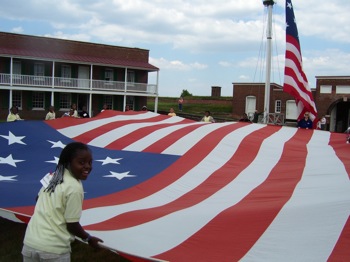
Courtesy National Park Service
In 1814, with British war ships sailing up the Chesapeake Bay toward Baltimore during the War of 1812, Maj. George Armistead, commander of Fort McHenry, commissioned a flag “so large that the British will have no difficulty seeing it from a distance.”
Mary Pickersgill was up to the task, and the ensuing huge flag and Francis Scott Key’s poem celebrating the successful defense of Fort McHenry against “bombs bursting in air” created an American icon and led to this country’s national anthem.
“This is the home of Mary Pickersgill,” said guide Greg Negved as we prepared to tour the Star-Spangled Banner Flag House, a short block from Baltimore’s Inner Harbor. “She made the flag that flew over Fort McHenry. We tell her story.
“If you remember anything, remember Mary. She has a pretty good story. It really is the story of the Star-Spangled Banner.”
The first thing you notice as you enter the house’s side garden is a large replica of the flag hanging behind a glass cover on the side of the adjacent visitors center.
“This is the actual size,” said Negved. “It was 30 feet by 42 feet. The stars are two feet tall. It had 15 stars and 15 stripes and contains more than 400 yards of fabric.”
Pickersgill, who was already a successful flagmaker when approached by Armistead, moved into the 18th-century house in 1806 and lived there for 50 years. Only a few of the furnishings, such as a clock in the business office, belonged to her, but the house is furnished as it would have been during the early 19th century.
Pickersgill was able to hand sew the flag in just six weeks with the help of her daughter, two nieces and two African-American servants. Because of its size, it was finished on the floor of a nearby brewery that has since been torn down.
The adjacent visitors center and museum has a fragment of the original flag, a short film about the making of the flag and an exhibit about the War of 1812.
The house is one of three sites — two near the Inner Harbor — associated with the national anthem, which will mark its 200th anniversary in September 2014. The others are Fort McHenry and the Smithsonian Institute’s National Museum of American History, on the mall in Washington, where the original battered and revered flag is displayed in a special room.
A new visitors center will open in March at star-shaped Fort McHenry, which looks much as it did when it beat back the British attack.
“It is the original fort that was here during the War of 1812,” said Vince Vaise, the public information ranger at the National Park Service historic site.
“The fort sits on 43 acres. On weekends in the summer, we have living history with the Fort McHenry Guard, who represent soldiers, sailors and citizens who defended the city during the War of 1812. In the afternoons, they do everything from fife and drum to cannon firing.”
Visitors can get a feel for how large the flag was at noontime flag talks. “Visitors get to unroll the enormous flag,” said Vaise.
The new visitors center will have five times the exhibit space and will have a new multisensory movie about the war. “There will be exhibit galleries about Key and the writing of the anthem, about the War of 1812 and about the flag and anthem over time,” said Vaise.
For more on Baltimore:
Baltimore’s inner self
Waterborne perspective
Raise the flag










